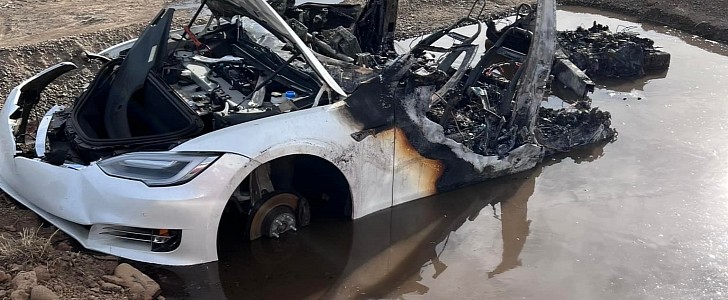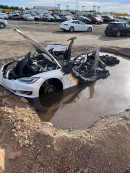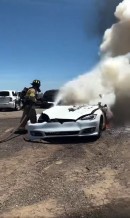EV fires are not more frequent than ICE (internal combustion engine) fires but, because of the increased difficulty in putting them out, apparent unpredictability and novelty, they tend to be more controversial – and noteworthy.
Tesla is the leading EV maker in the world right now. Directly proportional to the number of Tesla vehicles on the road is the number of Tesla fires. The latest incident of this kind shows just how dangerous, and time- and resource-consuming EV fires are.
A Tesla Model S had been sitting at a junkyard for three whole weeks after suffering complete damage in a crash, when it spontaneously burst into flames, the Sacramento Fire Department says on social media. Firefighters were called at a junkyard in Rancho Cordova, California, where the white Tesla had been brought in for dismantling, because it reignited itself three weeks after the crash.
When first responders got to the scene, the Model S was completely engulfed in flames, and repeated attempts to put them out were unsuccessful. Just as firefighters thought they were about to put out the blaze, the batteries would reignite. In the end, they had to dig a pit and fill it with water, so they could dunk the car inside.
“Even with direct penetration, the vehicle would still re-ignite due to the residual heat,” the fire department says. “Crews and on-site personnel then created a small pit, placed the car inside it, and filled the pit with water effectively submerging the battery compartment. The pit ultimately reduced the total amount of water needed, estimated at 4,500 gallons [17,034 liters], and limited the runoff of contaminated water.”
The fire was eventually put out and no injuries were reported. As with all things Tesla and EVs in general, the latest incident is being politicized online, drawing controversy. Controversy aside, the issue remains that EV fires present a new set of challenges for first-responders.
Speaking with The Washington Post, spokesperson Capt. Parker Wilbourn stresses that this fire isn’t about Tesla cars, but EVs in general. EV fires require more resources and more time than regular auto fires: without the dunking maneuver, an EV fire can take up twice the amount of water and up to 24 hours to put out, because the batteries continue burning until all energy is consumed.
“This is a whole new animal for the fire service,” Wilbourn explains. “We’re still trying to wrap our heads around the [electric vehicle] fires.”
A Tesla Model S had been sitting at a junkyard for three whole weeks after suffering complete damage in a crash, when it spontaneously burst into flames, the Sacramento Fire Department says on social media. Firefighters were called at a junkyard in Rancho Cordova, California, where the white Tesla had been brought in for dismantling, because it reignited itself three weeks after the crash.
When first responders got to the scene, the Model S was completely engulfed in flames, and repeated attempts to put them out were unsuccessful. Just as firefighters thought they were about to put out the blaze, the batteries would reignite. In the end, they had to dig a pit and fill it with water, so they could dunk the car inside.
“Even with direct penetration, the vehicle would still re-ignite due to the residual heat,” the fire department says. “Crews and on-site personnel then created a small pit, placed the car inside it, and filled the pit with water effectively submerging the battery compartment. The pit ultimately reduced the total amount of water needed, estimated at 4,500 gallons [17,034 liters], and limited the runoff of contaminated water.”
The fire was eventually put out and no injuries were reported. As with all things Tesla and EVs in general, the latest incident is being politicized online, drawing controversy. Controversy aside, the issue remains that EV fires present a new set of challenges for first-responders.
Speaking with The Washington Post, spokesperson Capt. Parker Wilbourn stresses that this fire isn’t about Tesla cars, but EVs in general. EV fires require more resources and more time than regular auto fires: without the dunking maneuver, an EV fire can take up twice the amount of water and up to 24 hours to put out, because the batteries continue burning until all energy is consumed.
“This is a whole new animal for the fire service,” Wilbourn explains. “We’re still trying to wrap our heads around the [electric vehicle] fires.”








